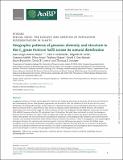| dc.contributor.author | Palacio-Mejía, Juan Diego | |
| dc.contributor.author | Grabowski, Paul P | |
| dc.contributor.author | Ortiz, Edgardo M | |
| dc.contributor.author | Silva-Arias, Gustavo Adolfo | |
| dc.contributor.author | Haque, Taslima | |
| dc.contributor.author | Des Marais, David L | |
| dc.contributor.author | Bonnette, Jason | |
| dc.contributor.author | Lowry, David B | |
| dc.contributor.author | Juenger, Thomas E | |
| dc.date.accessioned | 2021-10-07T15:31:22Z | |
| dc.date.available | 2021-10-07T15:31:22Z | |
| dc.date.issued | 2021 | |
| dc.identifier.issn | 2041-2851 | |
| dc.identifier.uri | https://hdl.handle.net/1721.1/132780 | |
| dc.description.abstract | <jats:title>Abstract</jats:title>
<jats:p>Geographic patterns of within-species genomic diversity are shaped by evolutionary processes, life history and historical and contemporary factors. New genomic approaches can be used to infer the influence of such factors on the current distribution of infraspecific lineages. In this study, we evaluated the genomic and morphological diversity as well as the genetic structure of the C4 grass Panicum hallii across its complex natural distribution in North America. We sampled extensively across the natural range of P. hallii in Mexico and the USA to generate double-digestion restriction-associated DNA (ddRAD) sequence data for 423 individuals from 118 localities. We used these individuals to study the divergence between the two varieties of P. hallii, P. hallii var. filipes and P. hallii var. hallii as well as the genetic diversity and structure within these groups. We also examined the possibility of admixture in the geographically sympatric zone shared by both varieties, and assessed distribution shifts related with past climatic fluctuations. There is strong genetic and morphological divergence between the varieties and consistent genetic structure defining seven genetic clusters that follow major ecoregions across the range. South Texas constitutes a hotspot of genetic diversity with the co-occurrence of all genetic clusters and admixture between the two varieties. It is likely a recolonization and convergence point of populations that previously diverged in isolation during fragmentation events following glaciation periods.</jats:p> | en_US |
| dc.language.iso | en | |
| dc.publisher | Oxford University Press (OUP) | en_US |
| dc.relation.isversionof | 10.1093/AOBPLA/PLAB002 | en_US |
| dc.rights | Creative Commons Attribution 4.0 International license | en_US |
| dc.rights.uri | https://creativecommons.org/licenses/by/4.0/ | en_US |
| dc.source | Oxford University Press | en_US |
| dc.title | Geographic patterns of genomic diversity and structure in the C4 grass Panicum hallii across its natural distribution | en_US |
| dc.type | Article | en_US |
| dc.identifier.citation | Juan Diego Palacio-Mejía, Paul P Grabowski, Edgardo M Ortiz, Gustavo Adolfo Silva-Arias, Taslima Haque, David L Des Marais, Jason Bonnette, David B Lowry, Thomas E Juenger, Geographic patterns of genomic diversity and structure in the C4 grass Panicum hallii across its natural distribution, AoB PLANTS, Volume 13, Issue 2, April 2021 | en_US |
| dc.contributor.department | Massachusetts Institute of Technology. Department of Civil and Environmental Engineering | |
| dc.relation.journal | AoB PLANTS | en_US |
| dc.eprint.version | Final published version | en_US |
| dc.type.uri | http://purl.org/eprint/type/JournalArticle | en_US |
| eprint.status | http://purl.org/eprint/status/PeerReviewed | en_US |
| dc.date.updated | 2021-10-06T16:47:48Z | |
| dspace.orderedauthors | Palacio-Mejía, JD; Grabowski, PP; Ortiz, EM; Silva-Arias, GA; Haque, T; Des Marais, DL; Bonnette, J; Lowry, DB; Juenger, TE | en_US |
| dspace.date.submission | 2021-10-06T16:47:49Z | |
| mit.journal.volume | 13 | en_US |
| mit.journal.issue | 2 | en_US |
| mit.license | PUBLISHER_CC | |
| mit.metadata.status | Authority Work and Publication Information Needed | en_US |
